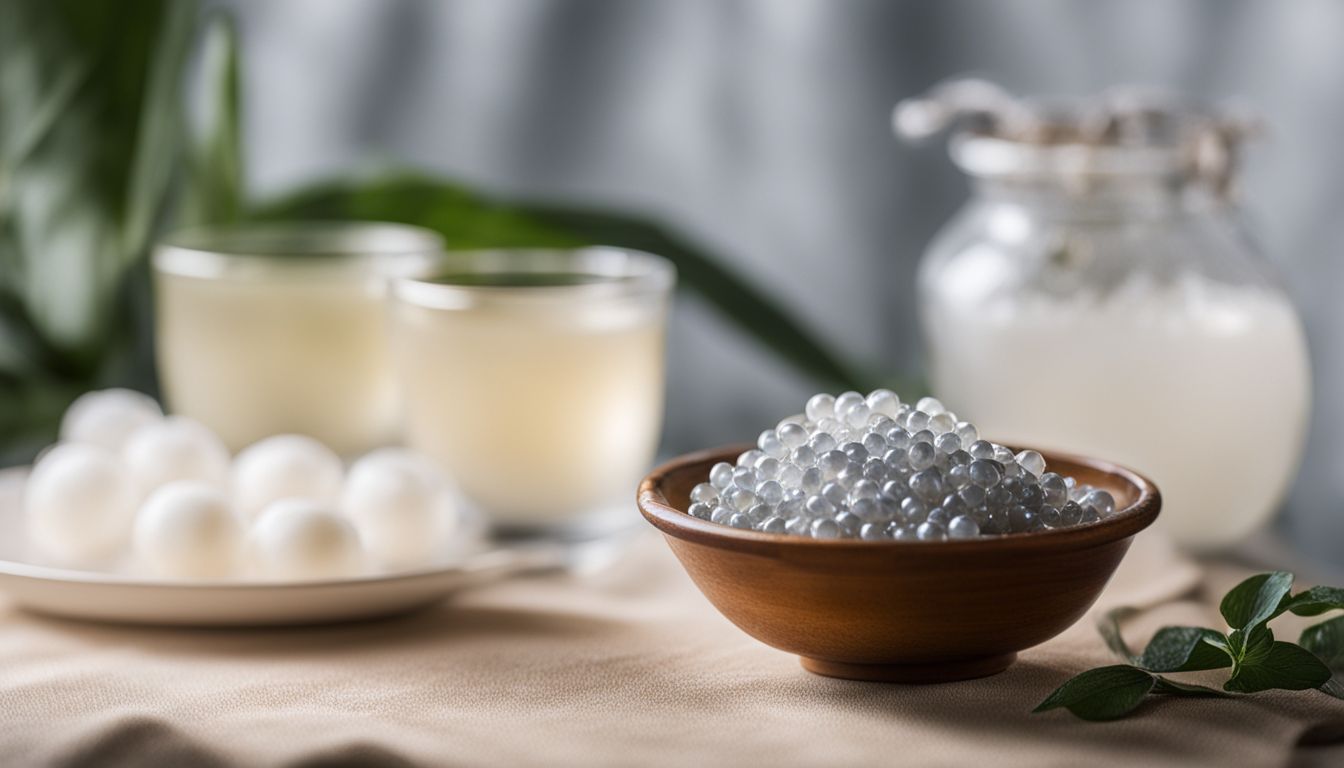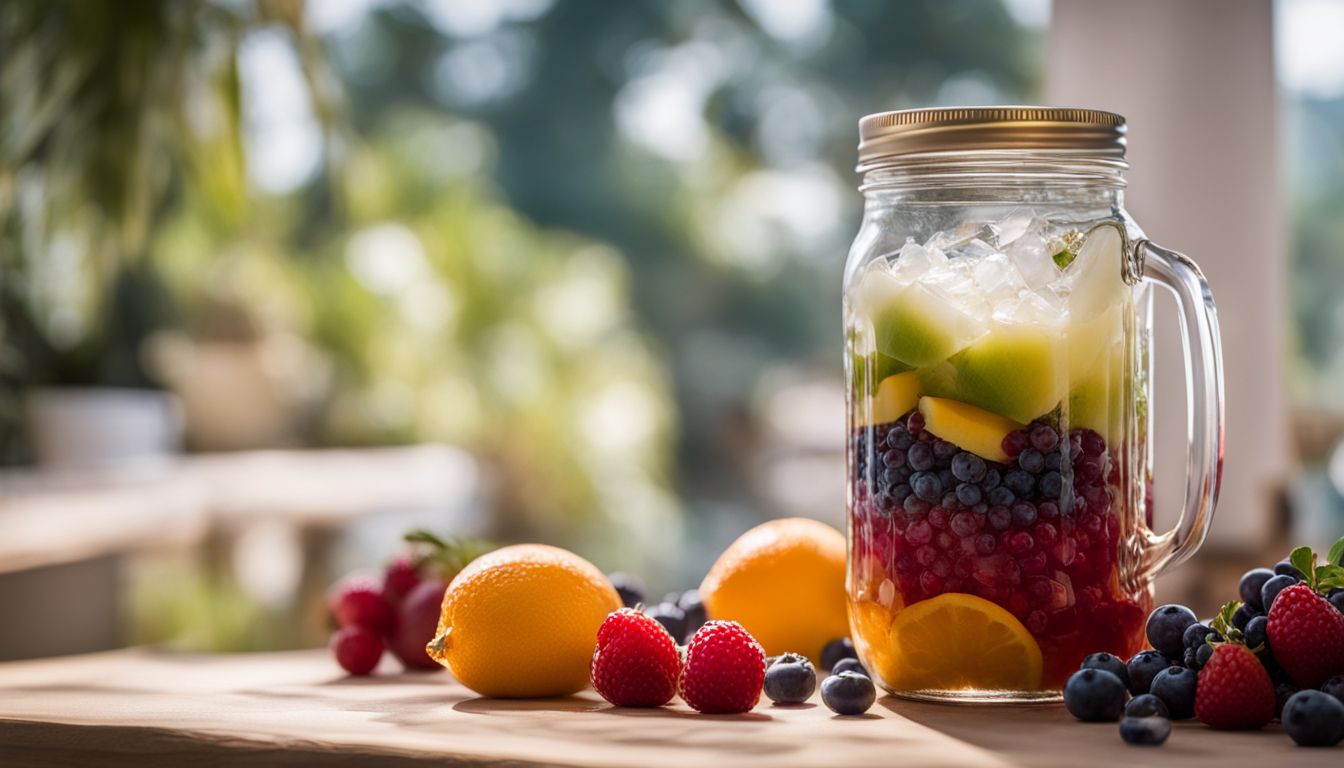– Boba is a popular drink with chewy pearls that many people love. Crystal boba and traditional tapioca boba pearls are two types of these chewy treats. Crystal boba is made from a plant called konjac and has only 70 calories for every 100 grams.
The normal tapioca boba you find in most drinks has more calories, at 63 per ounce, and also has extra stuff added to it like preservatives and colors. Some crystal boba is made with agar which comes from plants as well, making them good for vegans who don’t eat animal products and they don’t have gluten either.
People choose crystal boba not just because it might be better for their health but because it can take on the tastes of fruits used to make them. This means they can be part of tasty drinks without too much sugar or bad things in them.
Also, since you can make crystal boba at home using things like coconut water, you get to decide what flavors and how much sugar goes into your treat.
This article will talk about what’s inside both crystal and traditional boba pearls, why some think crystal ones are healthier, how to make them at home easily, plus other good things about choosing the jelly-like konjac-based choice over regular tapioca pearls.
Let’s look closer at these yummy drink additions!
Key Takeaways
- Crystal boba has only 70 calories per 100 grams, which is a lot lower than traditional tapioca boba that contains about 272 calories for the same amount.
- Made from konjac or agar, crystal boba is a good choice for vegans and people who don’t eat gluten. It’s important to check labels though, because some crystal boba might have honey in it.
- You can make your own healthy crystal boba at home with agar agar powder and your favorite flavors. This lets you control how sweet it is and avoids extra stuff like preservatives.
Nutritional Profile: Crystal Boba vs. Traditional Boba

Under the spotlight of nutritional scrutiny, crystal boba and traditional tapioca boba engage in a comparative dance that reveals striking differences in their caloric content and ingredient lists.
This analysis delves into the core of what makes each variant distinct, offering insights into not just their taste but also how they stack up against each other from a health perspective.

Caloric Content

Crystal boba is lower in calories than you might think. For every 100 grams, it has just 70 calories. This makes it a lighter choice if you’re watching your caloric intake.
Traditional boba pearls, made from tapioca starch, have more calories. An ounce of these chewy balls packs about 63 calories plus some extra ingredients like preservatives and artificial colors.
If you enjoy the classic taste of regular boba in your milk tea or flavored ice teas but want fewer calories, crystal boba could be the way to go.
Choosing crystal boba can help keep your snack’s calorie count down. Imagine adding them to your favorite bubble teas without feeling guilty about extra calories. Even when sweeteners or syrups are mixed into the drink, picking crystal boba may still end up being a less calorific option compared to traditional tapioca boba.
Ingredients and Health Benefits

Crystal Boba is a fun twist on traditional boba pearls. It’s made from the konjac plant, which comes from Southeast Asia. This special ingredient makes crystal boba not only chewy but also full of fiber.
These pearls have about 70 calories per 100 grams and are packed with carbohydrates that give you energy.
Traditional boba pearls, on the other hand, are usually tapioca balls. Tapioca is starchy and doesn’t offer much in terms of nutrients. These pearls often have added preservatives and artificial colors too.
Health-wise, crystal boba has more to offer than just being a low-calorie treat. Since it’s made with plant-based ingredients, this type of boba can be enjoyed by vegans as well! Plus, if you’re watching your sugar intake or can’t have dairy products due to allergies or lactose intolerance, choosing crystal over traditional could be a good move for your body.
After learning about how these bobas stack up nutritionally and health benefits they may bring let’s see why many consider crystal boba a healthier choice next!
Crystal Boba: A Healthier Alternative?

Examining the rise of crystal boba, many enthusiasts are curious if it stands as a healthier substitution to traditional tapioca pearls. Delving into this jelly-like variant reveals its potential benefits and how it may align with various dietary preferences and nutritional goals.

Low-Calorie Option

Crystal boba is a tasty treat with fewer calories. Each 100g serving has just 70 calories, much less than traditional boba’s 272 calories. This makes crystal boba a smart choice for those watching their weight or looking to cut down on calorie intake.
Crystal boba can be added to your favorite boba tea without adding too many extra calories.
This lighter option means you can enjoy more of the chewy texture and sweet taste that make boba teas so loved. Choosing crystal boba allows you to sip on your beloved drink while taking in fewer calories, making it easier to fit into a balanced diet.
It’s perfect for anyone who wants the fun of sipping bubble tea but also cares about staying healthy.
Vegan-Friendly

Many people love boba, but for those who eat only plant-based foods, finding vegan options is a must. Crystal boba is often a great choice because it’s made from agar powder instead of gelatin which comes from animals.
Agar is a gelling agent from seaweed and fits well with vegan diets.
Sometimes crystal boba can have honey in it. Honey isn’t vegan since bees make it. It’s smart to look at the ingredients list to be sure what you’re getting is truly vegan-friendly.
If you’re not into honey or want more plant-based choices, bubble tea shops might use natural sweeteners like stevia.
Agar boba gives everyone, including vegans, a way to enjoy chewy treats without worrying about animal products. This means even if you follow a strict diet for health or beliefs, you can still sip and savor all that bubble tea goodness! Next up: let’s figure out if this tasty treat also skips gluten.
Gluten-Free

Just like crystal boba is a great choice for vegans, it’s also perfect for people who can’t eat gluten. Gluten is found in wheat and some other grains, but not in the ingredients used to make crystal boba.
Since crystal boba uses things like agar-agar, it doesn’t have any gluten. This means that people with celiac disease or who are sensitive to gluten can enjoy it without worry.
Most of the stuff that goes into boba drinks, including the tea and milk alternatives like almond milk or coconut milk, are safe from gluten too. The toppings you might add are typically free from gluten as well.
This makes enjoying a cup of boba possible for those avoiding this common allergen. When you pick crystal boba over traditional pearls made with tapioca starch which sometimes has added ingredients that contain gluten, you’re making a safer bet for your stomach.
Crystal boba brings fun and safety together in one bite! It lets everyone join in on the joy of bubbly beverages without having to stress about hidden sources of discomfort. Whether at home or at a local shop offering Asian desserts like shaved ice or pudding topped with these clear jewels, everyone can sip happily knowing their treat is friendly to their dietary needs.
How to Make Your Own Crystal Boba: A Simple Recipe

Creating your own Crystal Boba at home is surprisingly straightforward and can be a healthier addition to your drinks. This homemade version also provides the flexibility to infuse your preferred flavors while controlling sugar intake.
- Begin by boiling 2 cups of water in a medium – sized pot.
- Once the water reaches a rolling boil, add 2 teaspoons of agar agar powder, stirring constantly until it dissolves completely.
- Reduce the heat to allow the mixture to simmer, ensuring the agar agar does not stick to the bottom of the pot.
- Incorporate 1/2 cup of white powdered sugar, or adjust according to taste preference for sweetness.
- If desired, mix in flavorings like fruit juices or coconut water for an added taste dimension; this step will also tint your boba naturally without food coloring.
- You may choose to add food coloring for more vibrant boba; just ensure it’s well mixed into the liquid.
- Remove from heat once all ingredients are fully integrated and dissolved.
- Pour the hot mixture into spherical molds or a flat baking dish if molds are unavailable. A syringe can be useful for precision when filling sphere molds.
- Allow the boba to cool at room temperature before placing them in the refrigerator to set. This process typically takes about 15 minutes.
- Once set and firm with that characteristic jelly – like texture, eject them from their molds if using, or cut them into small cubes if they were set in a baking dish.
Conclusion

Bubble tea fans, take note! Crystal boba could be your new go-to for a tasty treat with fewer calories. These clear pearls are made from the konjac plant and can soak up yummy fruit flavors.
Unlike traditional boba, which is heavier and comes from tapioca starch, crystal boba offers a lighter choice. For those wanting to skip dairy or gluten, it’s also friendly. Try making crystal boba at home for a fun and health-conscious twist on your favorite drink!
If you’re intrigued by the health benefits of crystal boba and want to try making it at home, check out our simple recipe for homemade crystal boba.
FAQs
1. What is crystal boba made from?
Crystal boba is made using gelling agents like agar agar, which comes from seaweed and is used as a thickener to create the chewy pearls.
2. How does crystal boba compare to traditional boba in nutrition?
Crystal boba often has fewer calories than traditional boba because it lacks brown sugar and whole milk, making it a better choice for health.
3. Can you find antioxidants in crystal boba?
Yes, if you mix matcha or berry flavors into your crystal boba, they can add antioxidants that help protect your body against diseases.
4. Are there any dairy alternatives for making homemade boba?
Sure! When you make homemade popping or bursting boba, use non-dairy creamer or milk options like almond milk instead of whole or skim milk to cut down on dairy.
5. Is traditional sugary drinks with brown sugar bad for your health?
Drinking too many sugary drinks like iced teas sweetened with lots of sugar syrup can lead to obesity and other health problems like non-alcoholic fatty liver disease (NAFLD).
6. Could eating too much regular tapioca pearl bobas cause allergies?
Some people might get allergic reactions from ingredients in certain bobas; finding out what’s inside before eating them is important because things like dairy products used in some bobas could cause issues if you have allergology concerns.
Was this helpful?

I’m Mary R. Q. , a seasoned professional chef dedicated to elevating home cooking experiences. Through my expertise in the culinary arts, I provide practical cooking tips and insightful reviews of kitchen utensils on my blog, milkwoodrestaurant.com. As a passionate advocate for transforming everyday meals into extraordinary culinary adventures, I aim to empower home cooks with the knowledge and tools they need to create delicious and memorable dishes. I’m also an author of the book “1,001 Kitchen Tips & Tricks: Helpful Hints for Cooking, Baking, and Cleaning (1,001 Tips & Tricks)” which is sold on Amazon. Join me on a flavorful journey as we explore the art of cooking and the essential tools that make it a joy.








